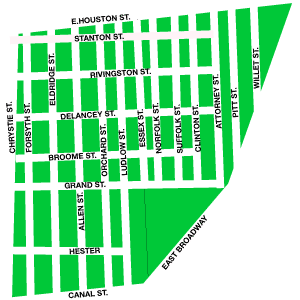
Johnson, a cozy boutique at 179 Orchard St., closed for good Oct. 15. The whimsical cardboard castle that dominated the window display is gone. Instead, there is a single, typed sheet of paper. It’s a farewell letter.
But just up the block the American Apparel chain’s Lower East Side store always attracts customers with its bright lights and even brighter clothing. And the employees at Steven, the more upscale branch of the global Steve Madden chain, on Rivington Street are busy helping shoe-seeking customers find the right fit.
The contrast between Lower East Side independent boutiques and company owned businesses is stark. More chains are moving in. Today they include Earnest Sewn (90 Orchard St.), Skunk Funk (181 Orchard St.), American Apparel (183 East Houston St.) and Steven (100 Rivington St.). These commercial stores have transformed the face of the neighborhood once dominated by artsy entrepreneurs.
“The creative people that started the neighborhood have all been evicted,” said Mary Adams, a former Lower East Side storeowner. “That’s not to say it’s not a nice neighborhood, it’s just completely different.”
Mary Adams The Dress had been a fixture on the Lower East Side for 25 years. The couture shop vacated its second Ludlow Street location this past May. Adams was evicted from her building on the corner of Ludlow and Stanton streets before moving to 138 Ludlow St. in 2001. The first eviction came about because, according to Adams, landlords “wanted all the old people out.”
During the seven years Adams spent at the second store, the neighborhood became even more inhospitable to longtime small business owners. She was eventually forced to leave the area entirely, relocating to Murray Hill, because of a sharp increase in real estate tax. Her bill spiked from $2,500 in 2006 to $18,000 in 2008.
Current rent prices are a far cry from what they were when Lower East Side was known for its thriving drug culture. In the 1980s and 90s artists moved into the neighborhood. They were followed by young professionals and as the arts scene gave way to music clubs and vintage shopping the area became a hipster haven. In recent years, the neighborhood has undergone yet another transformation, becoming increasingly attractive to luxury condominium developers and the companies behind chain stores.
According to Faith Hope Consolo, chairman of the retail leasing and sales divisions at Prudential Douglas Elliman Real Estate, rents have risen dramatically throughout the Lower East Side, with 40 percent increases not uncommon. As those that cannot afford such rent hikes leave the neighborhood, the area is beginning to appear more attractive to chains.
“The Lower East Side, historically an area for fairly new immigrants has been gentrifying in recent years,” Consolo responded in an email.
Steven is a product of this gentrification. The shoe store moved into the area in December. At one time, a family owned restaurant occupied the space. While Adams feels that such changes are pushing the neighborhood even further from its former bohemian character, Linda Micaj, Steven’s store manager, views the increase in company owned businesses as beneficial.
“You know what you’re buying here,” Micaj said. “Do you really want to spend $300 on a dress that someone else wore because it’s vintage? I know I don’t.”
Micaj is not the only one that supports the commercial shift. Mitchell L. Moss, a professor of Urban Policy and Planning in the Wagner School of Public Service at New York University, sees the changes in the neighborhood as unquestionably positive.
“The Lower East Side has become a much more attractive place for young people to live,” he said. “There’s a much more lively and interesting night life with more shopping.”
But Danielle Linzer, the education coordinator at the Lower East Side Tenement Museum, feels that increased commercialization threatens the immigrant community that currently calls the Lower East Side home.
“The developers aren’t the ones that stay and invest in the community but they are changing the neighborhood so that locals can no longer afford what’s for sale in businesses,” she said.
Local Naama Shefi also opposes the increase in upscale, commercial stores.
“If it continues like this I’ll probably move to a different place,” she said.
Mary Adams The Dress and Johnson already have.











